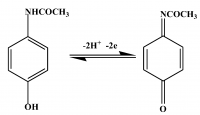Acetaminophen Induced Toxicity
Introduction
Acetaminophen (APAP) is a common analgesic and an active ingredient in many painkillers, ranging from over the counter medications like Tylenol to opioids such as Oxycodone. Seemingly harmless in normal dosages, large quantities of APAP can result in liver necrosis by depleting glutathione reserves in a dose dependent manner (). APAP misuse is responsible for approximately 50% of acute liver failure cases in the United States (). Treatments for Acetaminophen Induced Liver Injury (AILI) are limited and ineffective if not caught early enough. Considering this and the widespread use of APAP containing pharmaceuticals, it is imperative that the mechanism of acetaminophen induced hepatotoxicity be revisited.
The current accepted mechanism by which AILI presents itself is through a two electron oxidation as illustrated in Figure 1. Under normal conditions, APAP is mostly converted to nontoxic metabollites via sulfation or glucuronidation while a small percentage is oxidized by cytochromes P-450 to the proposed two electron oxidation product and highly reactive metabollite, N-acetyl-p-benzoquinone imine (NAPQI) (). NAPQI is suggested to then detoxified through conjugation with glutathione (). During overdose, glucuronidation and sulfation pathways are saturated, thus leading to more NAPQI production. This of course results in the hepatocellular supplies of glutathione becoming stressed as demand for the resource becomes higher than its regeneration (). The purported two electron oxidation product, NAPQI is then suggested to react with cellular membranes and proteins and opens the door to oxidative stress (). In turn, this wreaks havoc and leads to large scale hepatocyte damage and death.
However, this conclusion is not the only explanation, as NAPQI is reported to be rapidly reduced back into APAP in the presence of NADPH and other electron donors (2). A single electron oxidation characterized by radical APAP intermediates capable of polymerizing into dimers and tetramers is an alternative and overall less studied mechanism of toxicity. Such radical APAP intermediates have been shown to be produced in vitro by horseradish peroxidase through electron paramagnetic resonance (). The electron spin density of the previously cited study illustrates four possible radical intermediates as shown in Figure 2. The reactivity of the APAP phenoxyl radical could render this molecule responsible for the effects normally attributed to NAPQI (3). These radical intermediates are capable of dimerizing, trimerizing, and even tetramerizing into insoluble polymers. The insoluble nature of these radically polymerized products have the potential to clump together and precipitate both intracellularly and extracellularly onto cellular structures, thus suggesting a clinically relevant mechanism of damage.
Materials and Methods
Horseradish Peroxidase (HRP) was isolated and purified from locally grown horseradish root in order to mimic the proposed one electron oxidation of Acetaminophen (APAP) by the liver through Cytochrome P450 3A subfamily (CYP3A) in beaker based conditions. The enzyme was stored in -20 degrees Celsius
Results
References
1. Potter, DW; Miller, DW; Hinson, JA. Identification of acetaminophen polymerization products catalyzed by horseradish peroxidase. Journal of Biological Chemistry, 260,22 (1985). 12174-2180. Print
2. Dahlin, DC; Miwa, GT; Lu, AYH; Nelson, SD. N-acetyl-p-benzoquinone imine: a cytochrome P-450-mediated oxidation product of acetaminophen. Journal of Biochemistry, 81 (1984). 1327-1331. Print
3. West, PR; Harman, LS; Josephy, PD; Mason, RP. Acetaminophen: enzymatic formation of a transient phenoxyl free radical. Biochemical Pharmacology, 33(18) (1984) 2933-2936. Print
